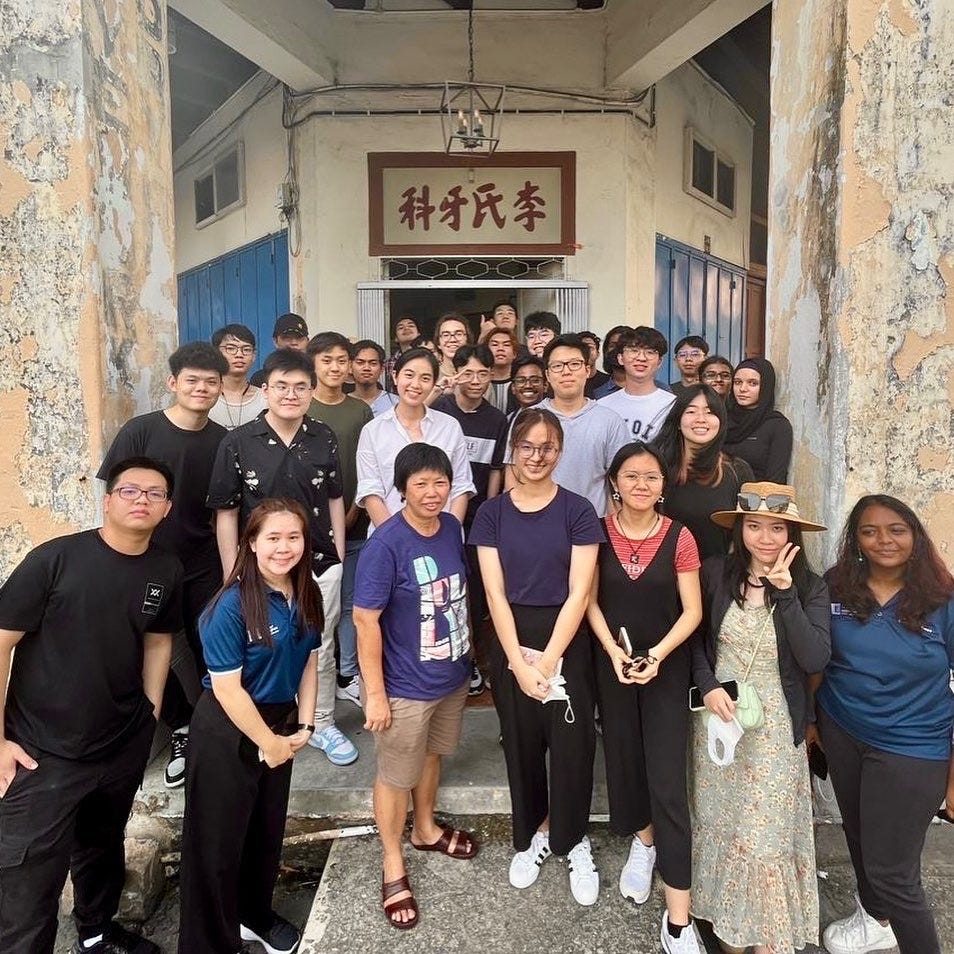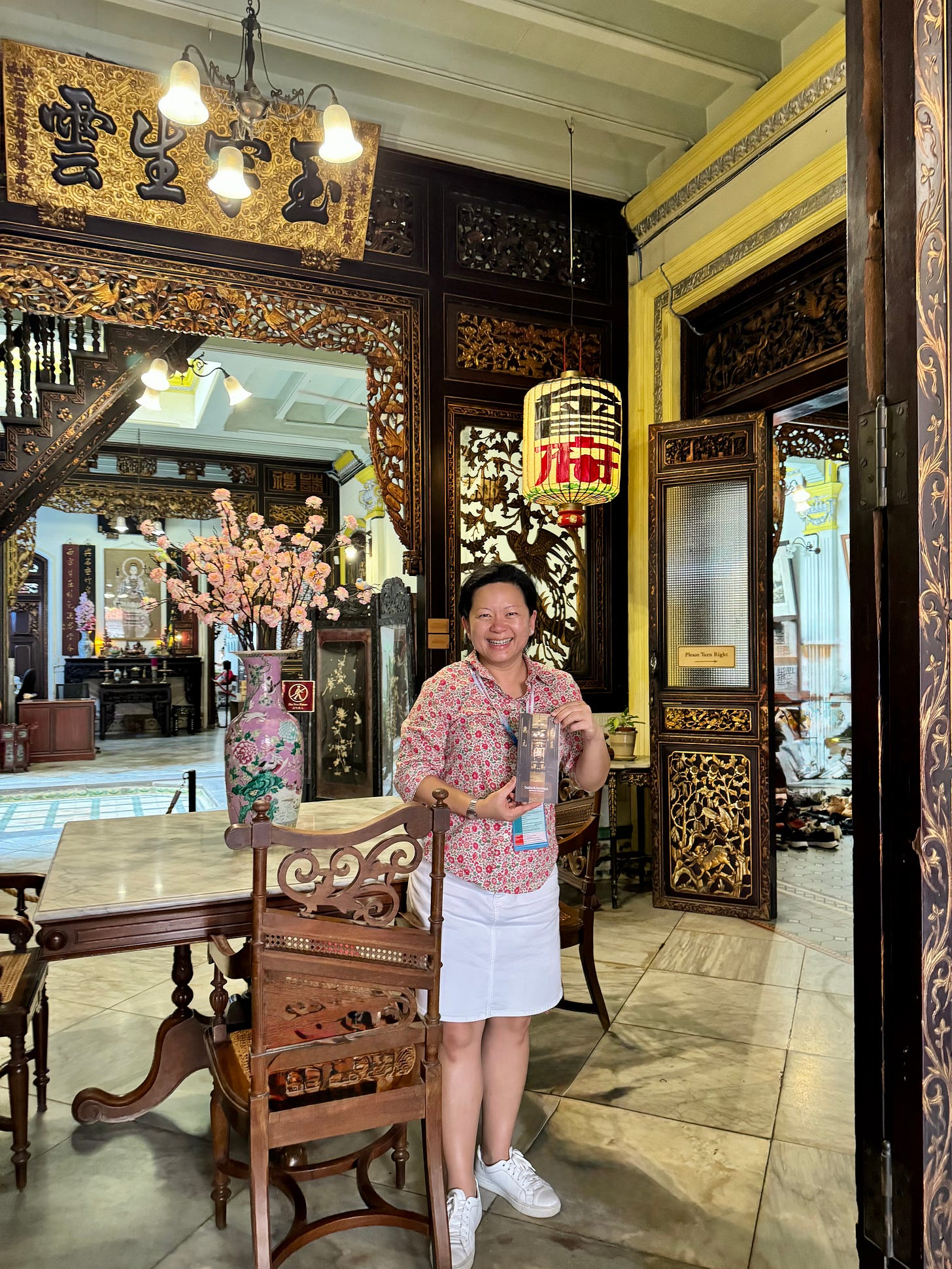In 1990, I rode a bus to Melaka to research the Peranakan culture for my university paper. I visited the Baba Nyonya Heritage Museum and took loads of photos of every aspect of its interiors. The house remains fascinating and I have gone back several times since. It was the setting for the hit TV series “The Little Nyonya” - a spin-off has just aired.
The museum was revolutionary for very possibly being the first private Peranakan ancestral home open to the public, ahead of other institutions that have since sprung up, including Singapore’s Peranakan Museum.
33 years later, I had the privilege of getting to know one of the descendants of the Chan family who owns and runs it. Melissa, like many of us, is keen to preserve the Peranakan culture and legacy. More significantly, she intends to safeguard this centuries-old storied port city through her new endeavour, The Bendahari. As this is the tourism year to visit Malaysia, also read on about her recommendations on what to do.
Tell us a bit about yourself – which city were you born in, what you used to work in, your interests and hobbies.
I was born in Kuala Lumpur. My interest in writing led me to work in advertising as a copywriter. After 10 years in the rat-race, I began to desire a more meaningful career path. This led me to work at the Baba Nyonya Heritage Museum which is a family-owned house museum in Melaka, and then later start The Bendahari in 2019.
I’ve been told that I am quite an intense person – that I should find a holistic life beyond work, but I do find my interests have led me to the work that I do! My interests lean towards discovering our identity through culture, bringing people together to find solutions together (this gives me joy), connecting with Jesus through prayer, long walks in nature, spending the day at a museum, and spending time with loved ones- family and friends. I also tried out pickleball but have yet to go back.
Can you introduce us to your family’s Baba Nyonya Heritage Museum in Melaka?
The museum was started in 1985 by my uncle, the late Baba Chan Kim Lay. Today it is operated by my cousins, with my 90-year-old father Baba Henry Chan as managing director. I had the opportunity to work at the museum from 2012-2018.
Of the museum’s accomplishments, what are you proudest of?
Personally, I am grateful that running the museum brought the extended family together to work on something bigger than ourselves, for Melaka and the Peranakan Chinese community.
What do you think are the most significant aspects of the Peranakan heritage and culture?
To me, family, is a significant pillar of the Peranakan culture and community. When you meet someone in Melaka who is Peranakan Chinese, usually the conversation would always steer towards how we are related to one another. “Oh we must be related through this person!”
It is a way for us to find our connection to one another.
When I was younger, to be ‘true blue’ Peranakan meant to solely be from Melaka. I’ve come to now learn and appreciate that the Peranakan heritage is far wider, and more encompassing. The mixed culture, the inter-mingling of different ethnicities form myriads of expressions of identity through art, language, food, is really to me what makes the Peranakan community so diverse, and so unique.
Whether Peranakan Chinese from Penang, Melaka, Terengganu, Kelantan; or Peranakan Jawi, Indian, Eurasian, I think the narrative of what makes us localized, what we keep culturally and traditionally, how we bridge identity as we move between nations, are fascinating aspects that we can learn from the past and from our forefathers, to continue to find our unique place in this culturally globalized world.
We’d love to know more about The Bendahari. What motivated you to set this up? What is your vision for it?
The Bendahari (meaning treasurer) has a vision to be a cultural community-built hub. The intention and hope are to set a benchmark for how we can take care of our shared culture and heritage, while making economic sense.
I was working at the Baba & Nyonya Heritage Museum in 2015 and had been making trips between KL where I lived, and Melaka. During that time, I noticed a significant amount of development changes that were happening to the city landscape. It felt like there was significant changes about to happen in this historical town. Hence the tagline for The Bendahari is “Old Roots, New Routes”.
How do we draw from our past to navigate into the future?
What are the forgotten aspects of Melaka as a heritage site that we should know more about? (Whether it is about food, craft, trade, monuments.)
I believe it is the people who make the place. For instance, working with Jennifer Tan of Donald and Lily has taught me a lot about the heart and soul of what makes Melaka unique. A lot of the time, we look towards monuments and our built heritage, to try to find a sense of place.
But how I personally experienced Melaka best, was through friendships formed. What the locals valued, and the way they do business is so relational and not transactional. It’s a very special intangible value that I have learnt so much from. Coming from a larger city, where a lot of how we operate is transactional, this is the biggest value I’ve learnt. I would definitely encourage visitors to take time to meet with the people here, they are the ones who carry the authentic soul of this heritage city.
You write. What have we not written enough about to document a plight or forgotten history?
The oral stories of minority communities can be documented more - their recipes, narratives and their memories of growing up in Melaka. We are experiencing so many changes globally, and now is that rare opportunity to document stories from anyone who lived anywhere between World War II or saw the independence of Malaya. What values mattered to them? I’m not sure what Generation Z or the subsequent generations would later decide to glean from these stories, but I do think if we don’t try to capture the stories, we could lose the possibility of building bridges between past and future generations.
To safeguard the Peranakan legacy, what would you suggest that we do?
There are many who are doing many wonderful things to try to safeguard the heritage. The challenge though is if and how it will be relevant to the next generation. I recently spoke with a lady who is trying to share the Baba Language, but one of her challenges is getting the younger generation to be interested. Personally, I do not have the answers. The future always belongs to the next generation. I think the best we can do is document voices from the past and build a platform perhaps that could allow the younger ones to discover how it could be culturally relevant to them today.
In my downtime, I am also trying to learn some recipes I grew up eating. Family legacies in the form of recipes being passed from one generation to the next is so precious because it holds not just the recipe but the memories of time spent with one another, the memory of shared breaking of bread, and that taste memory of food culture and moments with loved ones. Once while eating an egg skin popiah, I was moved to a point of tears because it brought me back to a time of family visits to my late aunt’s house, every Chinese New Year.
I think it will be good if we could just spend more time with our elders, ask their stories, document their lives, be investigators. It doesn’t have to be done professionally. Who we will share that with one day doesn’t matter. I have found the act of just sitting and listening to them is both cathartic for the older generation, and important for the younger generation trying to find their identity and place in the world. It also teaches one patience!
Since you have been surrounded by kebayas, jewelry, food, porcelain and furniture, rank these according to what you are most interested in, and why.
I do appreciate the artwork that has become symbolic of the Peranakan community.
· Kebayas & sarong – fashion! A form of expression for both the makers and the wearer. Where embroidery work comprised of anything from animals to floral art to even cartoon characters like Mickey Mouse. And the sarong pieces from Indonesia that were hand-done intricate designs. I appreciate the craft, the cultures that are represented in just one sarong kebaya, and the artisans of these cottage businesses.
· Food- this is more intimate for me, as it always reminds me of family visits to Melaka when I was younger.
· Porcelain
· Jewelery
· Furniture
What is your ideal Sunday? How would you spend it?
Definitely resting! Having that sabbath time to slow down, shut off from work, spend time with God, go for a walk in nature, take time to just read and be with loved ones.
Malaysia is such a beautiful country. Can you recommend the top 10 things to do in all of Malaysia?
1. Go diving in Sipadan (I am not sure if it is still as great. I went at least 10 years ago!).
2. Go to Sarawak, drive a 4WD into the interiors before it gets too built up.
3. Take a hike in a jungle or up the mountains of East Malaysia.
4. Take a train ride from Kuala Lumpur to Thailand.
5. Get to know a Peranakan Chinese in Terengganu (I want to do this).
6. Allow yourself to enjoy Melaka on a weekday, away from when the crowds come in.
7. Take a road trip through the trunk roads and small towns, and get a bit lost.
8. Take the ferry from Butterworth to Penang.
9. Stay on a farm of your choice (there are many different types all around Malaysia!)
10. Check into a silent retreat at Maranatha, Janda Baik.
What do you want to accomplish in five years’ time, whether it is the museum or The Bendahari, or yourself?
I am at a stage in my life where I am asking God for wisdom on how to steward time, energy and (the currently few) resources that I have. It is easy to get distracted and lose focus, and give attention to seemingly good but perhaps not long-lasting or valuable endeavours. So “seek first His Kingdom” has been a guiding Word for me.
My priority over the next five years is also family, being there for my parents. I don’t want to look back and regret not having spent time with them especially in their golden years.
After having run The Bendahari for five years, I desire for it to be a place of meaning which locals here would also be proud to be building together. It would be a milestone to see it flourish without me needing to be so involved in everything, that it would really have become sustainable economically and to become a well-managed community-grown organization.
I can’t speak on behalf of the museum, but when the time comes if/when am called to serve there again, to the capacity that I am able to, I most definitely would want to contribute to this endeavor together with my extended family, to keep it thriving for the next generation.









